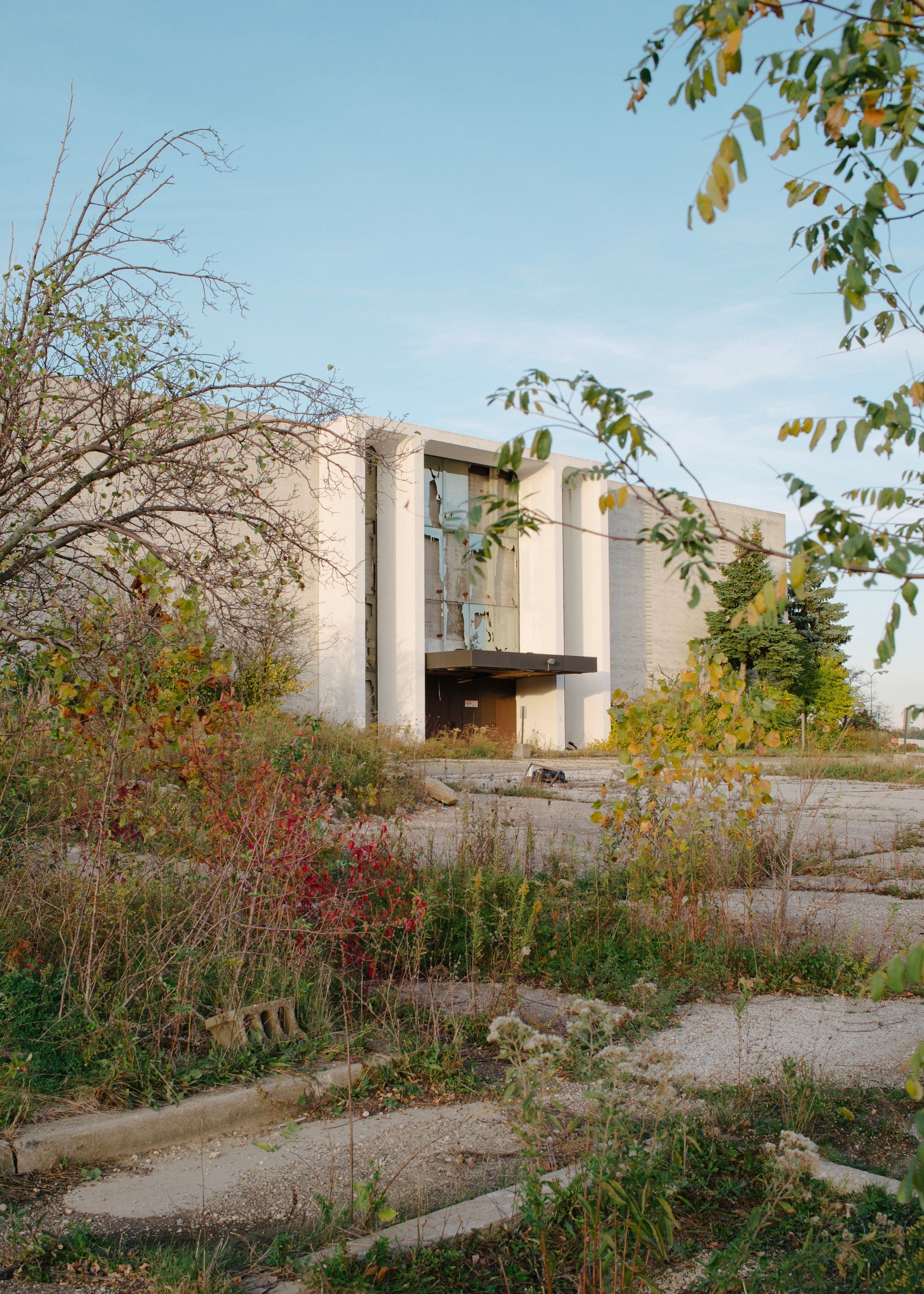Mountains Beyond Mountains, Tag Christof
Ghost Malls
There are no unsacred places; there are only sacred places and desecrated places. —Wendell Berry
When demolition crews arrived at Greengate Mall in May 2003, it marked the end of a decade-long financial collapse that had left the shopping mall in a state of obsolescence. Shuttered two years earlier, the vacant mall—a community fixture in and around the town of Greensburg, Pennsylvania, for nearly 40 years—was being razed to make way for a Walmart Supercenter. News of the demolition upset longtime customers and former employees, senior citizens who walked the concourses for morning exercise and former mall rats who came of age in Greengate’s neon hallways. Losing the mall also triggered an almost immediate sense of longing among those who adored it.
“It wasn’t just a place to shop,” said Gary Nelson. “It was a community center.” Nelson, who was born in the late 1980s, grew up going to Greengate. It was the mall his parents preferred. Before his family had a car, they would take a bus to the mall from where they lived in the nearby town of Jeannette. When asked to recall his most vivid memories of Greengate, Nelson cited dinners at Elby’s, playing video games at Tilt, and shopping at stores like G. C. Murphy and National Record Mart. His family’s trips to the mall, much like my own as a child, were experiences steeped in emotion.
Mountains Beyond Mountains, Tag Christof
“Walking through those doors, I remember the distinct smell of the perfume department,” Nelson said. “As we walked through the store and into the upper floor of the mall, the whooshing sound from the 30-foot-high fountain could be heard throughout the entire indoor courtyard.”
Greengate Mall first opened its doors in August 1965. Developed by James W. Rouse and designed by Victor Gruen, the mall featured all the requisite charm of a midcentury shopping center—decorative fountains, skylights, lush plant life, pastel birdcages, and benches dotting the thoroughfares. Situated at the gateway to the Laurel Highlands, a stretch of mountainous terrain located an hour east of Pittsburgh, Pennsylvania, it became a rural retail oasis—serving as a de facto town square among the area’s farmland and early postwar suburban developments. When a shopping mall is shuttered, particularly one as adored as Greengate, its community is not only displaced—they are fragmented.
“It was like a small town where everyone knew one another,” Nelson said of Greengate, referring not only to the people who worked there, but mall regulars too. In 2004, as a response to the void left by the closure of the mall, Nelson started a website called Greengate Mall Revisited. The site acted as an online time capsule to preserve the memory of the mall through photographs, videos, ephemera, and discussion. In 2011 much of the activity moved to Facebook, where Nelson started a public group as a hub for ex-Greengaters. Nearly two decades after the mall was demolished, the group continues to serve as memorial and scrapbook, forum and therapy session. The comments read like an overheard conversation among old friends.
Mountains Beyond Mountains, Tag Christof
“Loved that mall,” Sheri McDonald wrote in response to a photograph of Greengate’s food court from the early 1990s. “I was always there with friends on Fridays and Saturdays. Great memories!” In the photograph, the entrance to Montgomery Ward is visible and a slender, blonde-haired woman wearing a red apron stands in the foreground, broom and dustpan in hand. People are everywhere around her. Sitting at tables and walking the concourses lined with neon-lit storefronts. “No mall could ever replace Greengate,” wrote Kim Jo Golack. “Loved hanging with Terry Ranieri and they had the best Christmas displays.” When Faith Hall Baker chimed in, her sentiment punctuated the discussion: “Liked it better than any of the malls!”
Online eulogies for America’s vacant shopping malls are nothing new. Deadmalls.com, for example, the oft-cited authority on the ill-fated pleasure domes that dot the fifty states, has been operating since the turn of the century, going live as the rampant fear over Y2K still lingered in the nation’s collective memory. And while the legions of shuttered malls filed in the site’s archives have only grown larger over the last two decades, the practice of photographing and reminiscing about the dead or dying malls where many of us spent our youth has become a rather ubiquitous form of shared nostalgia in our online lives. For those whose childhood malls either no longer exist, sit empty, or teeter on the brink of closure, it acts as a form of catharsis.
In April 2014, after BuzzFeed published an article laden with images of abandoned malls from across the country, I noticed how the comments section became a much-needed emotional outlet for many readers. One woman, commenting on the derelict state of Rolling Acres Mall in Akron, Ohio, shared a particularly evocative memory.
“This is where I spent my childhood,” she wrote. “I made my first wish with a penny in a fountain here, played pinball in the arcade—Aladdin’s Castle—with my dad. My ears were pierced here, it’s where I saw my first movie, and I still crave the hush puppies and gyros sold in the food court. I came with my whole family here. Sat on Santa’s lap. I encountered the mystery of plasma globes and learned to see with the ‘magic eye.’ I would marvel at the massive palm trees and dream of going to Florida someday to see them in the wild— dead fronds of one is pictured in the fourth photo down, taken just beside the glass elevator that I always longed to ride up and down, as if teleporting. It became a central place for gang activity in the ’90s, leading to the eventual closing. I am not sad that this is its fate—I am sad that this was the landscape of my childhood in the first place, and that it’s impermanence can bring me to tears.”
Mountains Beyond Mountains, Tag Christof
The woman’s final sentiment, the acknowledgment that a shopping mall in suburban Ohio may not have been the ideal place to spend her childhood, is bittersweet. All of her emotions seemed to bubble to the surface as she typed, leading to that moment of recognition. Prefaced by such sweet recollections of time spent with her father, and the awe and wonder of experiencing the mall through the eyes of a child, it’s intriguing that as an adult she feels such regret. A certain language of loss pervades her words, a reckoning that deems the shopping mall an unsatisfactory place in her personal history. She sounds almost mournful—not only for the loss of the mall, but for the childhood she wished she had.
When Rolling Acres closed in 2008, the country was already slipping into the disquiet of the Great Recession. Banks were falling apart, American automakers were insolvent, and shopping malls were no longer being built. Even though Akron’s boom years were well behind it when the recession hit, Rolling Acres became a cautionary tale. A dead mall languishing in Northeast Ohio’s endless landscape, once a vibrant swath of the American Rust Belt, symbolized fading fortunes on a grand scale. Since then the mall has become a pilgrimage site for those who want to pay their respects—not only to the mall itself, but what it represented in their lives. Some are visitors who frequented the mall in its prime, whether as children, teenagers, or adults. Others are outsiders—urban explorers, mall enthusiasts, curious strangers—who have heard of the mall’s derelict condition and feel a need or desire to bear witness.
Photographer Tag Christof represents the latter. His curiosity has drawn him to Rolling Acres time and again in recent years. When asked what it is that brings him back, his response borders on poetic. “I’m looking for subtle signifiers of an exuberant bygone optimism,” he said. “Whether people realize it or not, the things I photograph are the direct result of a system that defines progress only in economic terms.” Born in New Mexico in the 1980s, Christof, who grew up visiting Villa Linda Mall in Santa Fe and Coronado Mall in Albuquerque, has spent the last five years crisscrossing the country in an effort to document architectural sites vanishing from the landscape. While his photographic project, dubbed America is Dead, doesn’t focus exclusively on shopping malls, they play a prominent part in illustrating his view of an America that no longer exists.
Unlike other photographers who frequent dead malls, particularly those who traffic in the type of ruin porn that dominates the internet—feeding a growing public obsession with real-world dystopian landscapes—Christof’s approach is far more measured. Often shot with a Bronica medium format camera loaded with Kodak Portra film, his photographs are imbued with lush color and natural light that temporarily resuscitate the hallways, storefronts, and entrances of deserted malls like Rolling Acres. One image from a recent trip to the mall captures the label-scarred facade of a department store bathed in golden sunlight as evening approaches. Towering light posts stand like quiet sentinels in the foreground, while overgrown pines cast shadows against painted white brick. In another of Christof’s photographs, this one taken in the food court at Canton Centre Mall in nearby Canton, Ohio, an Orange Julius sits empty but alive, so much so that you can almost envision a line of teenagers queued at the counter.
Viewed together, Christof’s images offer an ode to American aspiration and its rewards, tempered by the reality of what happens when economies fail and people stop buying. Each photograph is as much about the past as it is about the present and future, as much about what happens before a photo is taken, as it is about what happens after. Maybe that’s because Christof’s ethos is akin to photographers like Stephen Shore or Robert Adams, whose affinity for American landscapes and quotidian scenes show reverence for the common places that become sacred in our lives. He also approaches his work with a deep interest in not only the place he is photographing, but also the people to whom it mattered. In the many conversations he’s had with strangers outside of dead or dying shopping malls, Christof has discovered that his role is as much about looking as it is listening. Rolling Acres is no exception.
“People recall celebrity visits, holiday decorations, beautiful carousels, awkward first dates, their first splurge purchases, first jobs, and saving their allowances to buy something from a resplendent toy store,” he said. “Most talk about how, by the late 1990s and mid-2000s, they just stopped going there.”
To describe these shopping malls as dead is almost unfair. Certainly they no longer function as intended; there are no more products on display or commodities available for purchase. If anything, these vacant malls have entered a new phase, one where trees take root in cracked floor tiles and feral cats pass unnoticed—where curiosity seekers find meaning in the afterlife of a place that has long outlived its original intent. These are the ghost malls, places where past, present, and future simultaneously collapsed.
Ghost malls like Rolling Acres dot the country. In Northeast Ohio alone, there is Euclid Square Mall, Randall Park Mall, and Canton Centre Mall. To speak the names of shopping malls where the lights have permanently gone dark is like reciting an incantation: Cloverleaf Mall in Chester Field, Virginia; North Towne Square Mall in Toledo, Ohio; Woodville Mall in Northwood, Ohio; Crestwood Mall in St. Louis, Missouri; Hawthorne Plaza Mall in Hawthorne, California; Dixie Square Mall in Harvey, Illinois; Turfland Mall in Lexington, Kentucky; and Greengate Mall in Greensburg, Pennsylvania.
No mall is forever; their lifespan, like our own, is finite.
This essay is from the book Shopping Mall and was published by The Outline in September 2017 as an excerpt. Photographs by Tag Christof.
Mountains Beyond Mountains, Tag Christof




